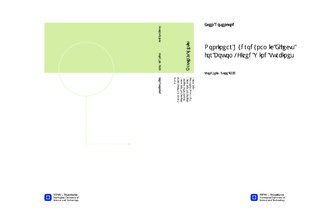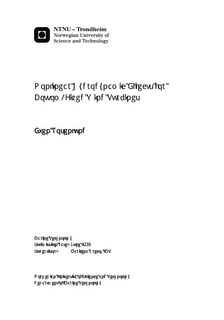| dc.description.abstract | This master thesis investigates possible effects from nonlinear wave loading onbottom fixed offshore wind turbines. The resonant phenomena springing andringing are reviewed with focus on their cause, and their possible occurrence ina bottom fixed wind turbine.To investigate the effect of a nonlinear wave load model on a wind turbine, thecalculation scheme in the wind turbine design-tool FAST has been extended witha new wave load model. The proposed load model was chosen because it couldbe coupled with fully nonlinear incident waves, and it is also expected that itcan predict some aspects of the loads leading to ringing in a structure. Theload model was developed by Rainey, and is based on conservation of energyarguments.The new load model is compared with experiments on a cylinder in regular waves,and with the existing load model in FAST (Morison?s equation). The numeri-cal wave generation has been performed with a nonlinear Fourier approximationmethod, developed by Fenton. Results show similar prediction of the first har-monic load, which is slightly underpredicted by both. Good comparison is presentfor the second harmonic for low kr-values for both models. However, for largerkr-values significant overprediction is present, with Rainey predicting the largestvalues. Reasonably good agreement is found or the high kA-values for the thirdharmonic, when calculated by Rainey, while some underprediction is present whencalculated by Morsion. The results also indicates that for slender structures, thenonlinearities in the incident waves, give a larger contribution to the loads thannonlinearities originating in the load formulation.Simulations performed on a full scale turbine, have shown small differences be-tween the two load models for turbine with a running rotor. Differences betweenresults with a linear irregular sea and a fully nonlinear irregular sea are somewhatlarger, but still the effect on improving the wave model is limited. This is due tothe fact that the motion of the turbine is governed by the aerodynamic forces.When the rotor has been set in a parked condition, sever springing occurs forall sea states investigated. The springing in a parked condition sometimes has aburst-like increase in amplitude, and time evolution of the tower top deflectionis close to the one observed for ringing. However, no clear cases of ringing havebeen observed in these simulations. Both load models predicts the resonantoscillations, when used with either linear or fully nonlinear waves. The amplitudeof the resonant oscillations are however dependent on the incident wave model. Ingeneral the fully nonlinear incident wave model leads to larger amplitudes in theresonant oscillations. For the case of fully nonlinear waves, there is a differencebetween the two load models, which is not present when linear waves are used.Wave induced resonant oscillations have not been encountered when the turbineis running, which indicates that the reason for the resonant oscillations in aparked condition is the lack of aero-elastic damping. Some signs of a transientresonant phenomena is seen in strong winds, with additional indication that it isnot triggered by waves, but the amplitude of the oscillations might be affectedby the wave loading. | nb_NO |

